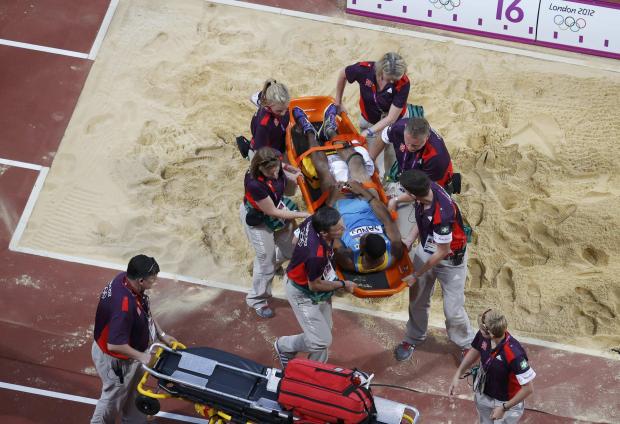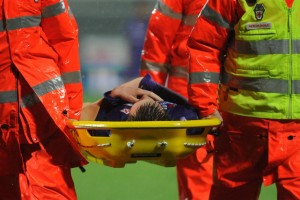
First Aid in Sport: how should immediate care be provided?
Medical defence/indemnity unions have made a clear unambiguous statement – pitchside doctors and physios must ‘have the appropriate recognised qualifications, training and experience for the health services they provide. This is expected from GP’s and physiotherapists who may also undertake such services’.
First Aid in Sport: the days of finding a local Doctor who happens to be nearby or a relative of the players to  “cover a game” are over. That is to say that if you are attending a sporting event as a Doctor or physio with the expectation that you will be dealing with any injuries, you need to demonstrate that you have the training, the requisite skills and equipment to deal with the injuries that can be expected. These may be life or limb-threatening. Are you ready?
“cover a game” are over. That is to say that if you are attending a sporting event as a Doctor or physio with the expectation that you will be dealing with any injuries, you need to demonstrate that you have the training, the requisite skills and equipment to deal with the injuries that can be expected. These may be life or limb-threatening. Are you ready?
First Aid Sport: what is the actual situation?
The provision of immediate (or pre-hospital) care has changed significantly in the last ten years. It is a rapidly changing subject with some excellent examples of dogmalysis with the application of some simple questions and evidence-based research.
Great examples of recent dogmalysis and changes to previously held ‘beliefs’ in pre-hospital trauma care:
- “Aggressive resuscitation” – 2 ltrs of crystalloid stat for hypovolaemia has been shown to be harmful. It has given way to ‘balanced resuscitation’. 250 mls aliquots and reassess… The most recent iteration of ATLS has finally changed to reflect this.
- Nasopharyngeal airways – who on earth ever dreamt that a patient’s (or anyone’s) little finger correlates with the size of a nasal passage? That is out. Broadly speaking ‘normal’ size ladies should get a size 6 NPA and blokes a size 7.
- OP airways – the inverted technique has been shown to occasionally cause trauma to the palette – placement the right way around with direct vision and some form of tongue depression is more simple in most cases.
- Spinal boards / long boards were not invented to transport a patient on and these are no longer recommended as a means of transporting casualties with possible spinal injuries. Enter split boards and vacuum mattresses
Providing first aid in sport is different to many other pre-hospital environments. There are different mechanisms of injuries, different physiology in the athletes, different dangers and conditions.
Immediate care in sport: dealing with significant injuries
Being skilled in trauma management in ED or being ATLS trained is undoubtedly useful, but there are important differences. This is why in some countries immediate care itself is now recognised as a stand-alone specialism (UK: Faculty of pre-hospital care).
Of course, the principles of dealing with any trauma patient (or medical emergency) are the same – safe approach, A-B-C-D-E. But remember, in the sporting context this may be only minutes after an injury is sustained and your ability perform a comprehensive primary survey as is limited, as is how you can deal with any time-critical injuries that need intervention.
Significant injuries don’t just happen on the day of sporting events. 80% of a professional athlete’s time is spent training. Rugby Union has several high profile cases of significant spinal cord injuries that occurred during training, not at a match.
At the training ground, there is even less backup and certainly no ambulance present at the time. Sports physios need to be adequately trained too.
Accidents in sport: not just about contact sports
Accidents can happen in almost any sporting environment. The 2014 soccer world cup had several examples of athletes who had a loss of consciousness from head injuries and none of these was managed appropriately (with the protection of the cervical spine) and some were allowed to stay on the field of play clearly concussed. In light of this, FIFA has recently changed its guidance on the management of concussion.
County cricket in the UK recently had two fielders collide – both were unconscious as a result and one had a fractured mandible (neither got the catch). In 2012 an English Premiership footballer called Fabrice Moamba had a televised VF arrest on the football field from previously unknown hypertrophic cardiomyopathy (thankfully, he survived – its good to have an AED and two cardiologists in the crowd and a tertiary hospital nearby).
In 2014 in Australian rugby league – a player fractured C4 and C5; with predicable devastating results. Do we really need to wait for more dreadful events to happen in different sports before there is change to how the pitchside care is provided?
First Aid in Sport: the Immediate Care in Sport program
The Immediate Care in Sport (ICIS) program, designed and directed by Dr Andy Smith (Mid Yorkshire NHS Hospitals Trust, UK, Yorkshire Ambulance Service, UK) and supported by the (English) Rugby Football Union has been running in for 10 years in the UK; the course is overseen and endorsed by the Royal College of Surgeons Edinburgh Faculty of immediate care (UK).
ICIS has now trained over one thousand doctors, physios, sports rehab and nurses from multiple different sports and National institutions. In recent years ICIS has started to move to other countries. Furthermore, it’s sister course, the Immediate Care In Rugby (ICIR) has recently been adopted by the World Rugby (formerly the International Rugby Board).
There was also a strong drive for change in the UK (and internationally) from the medical defence unions – you should not be providing immediate pre-hospital care unless you are properly trained. The ICIS program of training has the potential and ability to make a highly significant difference to players and athletes with time-critical injuries and medical emergencies around the world. It is not overstating the impact to of this course to say that lives, limbs and spinal cords have already been saved.
The Importance of Training Pitchside Doctors
Pre-hospital immediate care has rapidly expanding evidence base. This is a time of rapid change and there is a need to stay updated. Unless we regularly practice our practical trauma skills, we will also be unable to perform the procedures.
Pitchside medics of any provenance need to be adequately trained (just ask the medical defence unions that may (or may not) be providing your indemnity). Furthermore, in many sporting arenas, the medical facilities and equipment are outdated, inadequate and lagging years behind. There is a need for urgent change.


